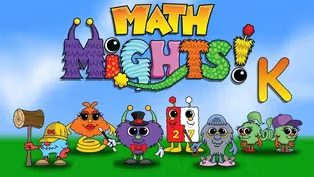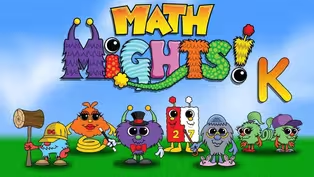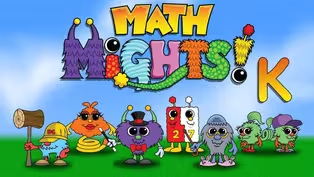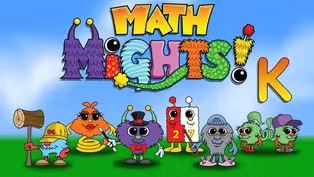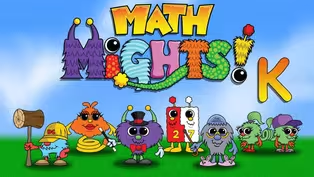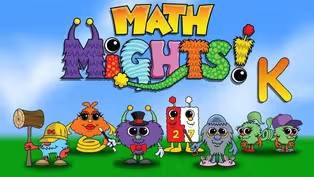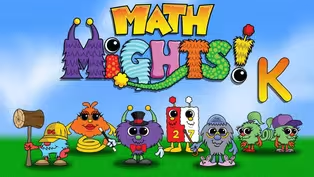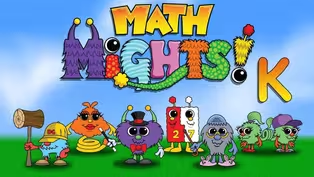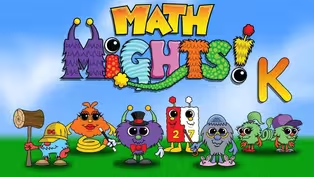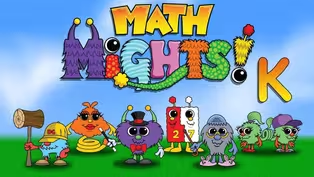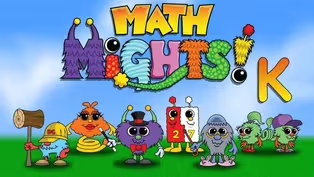Math Mights
Compose & Decompose Numbers to 9
Season 3 Episode 306 | 16m 1sVideo has Closed Captions
Join Mrs. Gray for a word problem with Professor Barble!
Join Mrs. Gray for a word problem with Professor Barble! Get your mallet ready to work with D.C. as we decompose and compose numbers with snap cube trains!
Problems playing video? | Closed Captioning Feedback
Problems playing video? | Closed Captioning Feedback
Math Mights is a local public television program presented by Detroit PBS
Math Mights
Compose & Decompose Numbers to 9
Season 3 Episode 306 | 16m 1sVideo has Closed Captions
Join Mrs. Gray for a word problem with Professor Barble! Get your mallet ready to work with D.C. as we decompose and compose numbers with snap cube trains!
Problems playing video? | Closed Captioning Feedback
How to Watch Math Mights
Math Mights is available to stream on pbs.org and the free PBS App, available on iPhone, Apple TV, Android TV, Android smartphones, Amazon Fire TV, Amazon Fire Tablet, Roku, Samsung Smart TV, and Vizio.
Providing Support for PBS.org
Learn Moreabout PBS online sponsorshipMore from This Collection
Video has Closed Captions
Join Mrs. Gray for a subtraction word problem with Porfessor Barble! (15m 52s)
Video has Closed Captions
Join Mrs. Gray for a subtraction word problem with Porfessor Barble! (15m 59s)
Video has Closed Captions
Join Mrs. Gray for a subtraction word problem with Professor Barble! (15m 59s)
Video has Closed Captions
Join Mrs. Gray for a subtraction word problem with Professor Barble! (15m 59s)
Break apart pattern block designs
Video has Closed Captions
Join Mrs. Gray for a word problem with Professor Barble! (15m 59s)
Video has Closed Captions
Join Mrs. Gray for a word problem with Professor Barble! (15m 59s)
Addition & Subtraction Expressions
Video has Closed Captions
Match fun story problems with the correct addition or subtraction expression. (16m 15s)
Video has Closed Captions
Join Mrs. Gray for a word problem with Professor Barble! (15m 59s)
Subtraction with Word Problems Part 2
Video has Closed Captions
Join Mrs. Gray & Dotson for a Numeracy Talk with My Counting Buddy Junior! (16m)
Video has Closed Captions
Join Mrs. Gray & Dotson to talk about numbers with My Counting Buddy Junior! (16m)
Addition Word Problems with Quick Draws
Video has Closed Captions
Join Mrs. Gray for Numeracy Talk with Dotson working on conservation to 10. (16m)
Providing Support for PBS.org
Learn Moreabout PBS online sponsorship(playful music) (electronic bells ringing) - [Children] Math Mights!
- Hi, kindergarten Math Mights!
Thanks for joining me today.
My name's Mrs. Gray, and I can't wait to do math with you, Today, we're gonna be doing a word problem with our friend Professor Barble.
We're also going to be doing snap towers into two parts.
Get ready!
Here comes our friend, Professor Barble.
(triumphant music) Professor Barble is a character from Mathville.
He wears a hat.
That is his thinking cap.
On the hat, there is a pole.
On the top of the pole, there are four arrows.
Those arrows always help Professor Barble to remember to stop when he comes to a word problem and think about what direction he needs to go with it.
When Professor Barble gives us a word problem, he wants us to go nice and slow to think about each part.
We are gonna be doing our word problem on our kindergarten math journal template.
This will help us be able to draw out and see each part of the math story.
Today, Professor Barble has a story for us.
I'm gonna read you the word problem for today.
It says, "Brian and Aiden played putt-putt.
"Putt-putt is a game of golf.
"Brian hit five balls into the hole.
"Aiden hit two balls into the hole.
"How many balls did Brian and Aiden get into the hole?"
Now we're gonna read the word problem again.
And this time I will read it first, and then you will read it after me.
We're gonna be chunking the different pieces of information that we find in the word problem.
It says, "Brian and Aiden played putt-putt.
"Brian hit five balls right into the hole."
Can you read that with me?
"Brian and Aiden played putt-putt.
"Brian hit five balls right into the hole."
This is where we're gonna add in our first chunk because that is our first piece of information.
Let's keep going.
"Aiden hit two balls right into the hole."
This is where you're going to read it after me.
"Aiden hit two balls right into the hole."
This is where we're gonna add our second chunk for our second piece of information.
The next part says, "How many balls "did Brian and Aiden get into the hole?"
Can you read it with me?
"How many balls did Brian and Aiden get into the hole?"
This is where we're gonna chunk for our third piece of information.
Let's take a look at the sentence form that goes along with this story.
It says, Brian and Aiden got hmm balls into the hole.
Remember, when we see that line, we always say, hmm, because we don't know the answer.
We're gonna add that in later.
Now we're gonna go to our work mat and we're going to be building out the story problem.
Brian and Aiden played putt-putt Brian hit five balls.
One, two, three, four, five.
Aiden hit two balls.
Let's add them on our mat.
One, two.
How many balls did they hit together?
Can you count with me?
One, two, three, four, five, six, seven.
They hit seven balls.
Now we're gonna go to our journal template and do our quick draw.
There were five balls that Brian hit.
One, two, three, four, five.
Aiden hit those two balls.
Let's add them on our journal template.
One, two.
Now we're gonna take our quick draw and we're gonna organize it into our 10 frame.
Brian hit five.
One, two, three, four, five.
And Aiden hit two.
Let's organize that.
One, two.
Now we're gonna take that information and we're gonna put it into our number bond.
Here is where we're gonna put five for the five balls that Brian hit.
Here is where we're gonna put two for the two balls that Aiden hit.
When we have five and we have two, when we put them together, it makes the seven balls.
Let's add that to the top of our number bond.
Five and two makes seven.
Now I can take that information and make my number expression.
Let's write it.
Five plus two equals seven.
I made the choice to put plus because this is an addition problem.
We took the five and the two.
When we put them together, we got more.
And that is what happens during addition.
We always get more because we're adding them together.
Let's go back to our journal template and fill in the number sentence.
It says, Brian and Aiden got hmm balls in the hole.
Well, we know that they got seven, so let's put it on our line.
Now read it.
Brian and Aiden got seven balls in the hole.
Great job kindergarten Math Mights!
You are working so hard on slowing down and doing each part of the word problem.
Professor Barble would be so proud of how hard you're working.
Let's take a look at the I can statement for the lesson today.
The I can statement is, I can compose and decompose numbers up to nine with towers.
Take a look at these pictures.
What do you notice?
What does it make you wonder?
Each of those pictures shows us different towers.
We have two friends here today to help us to share their thinking.
Ronan and Damien are here to share what they thought when they saw the pictures.
Ronan saw that there are connecting cubes, and each of the sets was broken into two parts.
Let's take a look at the board.
Here is the first picture.
Here's the second.
And here is the third.
Ronan noticed that each of them were broken into two parts.
Let's see what Damien saw.
Damien noticed that each of the towers had fix together as a total.
We can add that on our number bond to show Damien's thinking.
Damien noticed that total.
There were six red tower cubes.
There were six orange.
And there was also six green.
Let's take a look at what they wondered when they looked at the pictures.
Our friend Ronan wondered why each of the towers was broken into two parts.
Let's take a look.
He wondered why the red tower was broken into two pieces, as well as the orange and the green.
Our friend Damien wondered why each of the parts were different numbers.
Let's take a closer look.
He noticed that for the red tower, they were three and three.
Let's add it to our number bond.
He noticed that for the orange, there was four and two.
Let's add it to the number bond.
And he noticed for the green that there was one and five.
What did you notice?
What did you see that was the same?
Let's go back to our board to see what we can see.
When we look here, we can see that each of them totaled six.
That means the two pieces of tower they had when they put them together, it always made six.
Great job, Math Mights!
Wow!
All of this breaking apart of the cube makes me think of another Mathville character.
My favorite Mathville character is coming to visit today.
His name is DC.
Can everyone say, hi DC!
DC is a Mathville character who always carries around a big mallet.
A mallet is like a big hammer.
He carries it around because he likes to break apart numbers.
His name DC comes from decomposing and composing.
Those are things that we do in math.
Decompose means he takes a number and he breaks it apart into two pieces.
Composing is the opposite.
It means two pieces are being put together to make a new number.
Here's DC now to play a game with us called snap the cubes.
Player one is gonna snap the cubes.
DC is gonna use his mallet to help him.
Can you tell DC to snap the cubes?
Tell him, say, DC, snap the cubes!
(symbol crashing) Great job!
Thanks for helping, DC.
Now player two is going to describe how his friend snapped the cubes.
Ronan said that, "Damien broke the tower "into a group of five and a group of three."
Let's take a look at our mat so we can do what Ronan said.
We're gonna break it into the five and the three.
Now we're gonna use the recording sheet.
I'm gonna use blue to record the five.
One, two, three, four, five.
The second part was three.
I'm gonna use the green to record the three.
One, two, three.
Now we can write our number expression that will match the towers.
Let's take a look at our template.
So we had five blue.
So we're gonna write five, plus three.
I chose to use addition because this is an adding problem where we take the two numbers to put them together.
Let's see how many there were altogether.
Can you count with me?
One, two, three, four, five, six, seven, eight.
Five plus three equals eight.
That was so much fun!
Now it's Ronan's turn to snap the cubes.
DC's gonna help him.
Can you tell DC to help?
Say DC, snap the cubes!
(symbol crashing) DC helped us snap the cubes, but they're snapped differently.
Let's hear what Damien has to say about Ronan's towers.
Damien said that, "Ronan broke the tower "into a group of four and four more."
Let's go to our mat so we can see his thinking.
Here's our tower and it was broken into four and four.
Now we're gonna record his thinking on our mat.
The first part I'm gonna use is gonna be with blue.
We're gonna go one, two, three, four.
The four blue shows the first part.
Now we're gonna do green for the second part.
One, two, three, four.
Now that we've recorded it, we're gonna try to write the number sentence to go with it.
The first part was four plus four equals, can you count with me to see how many it was total?
One, two, three, four, five, six, seven, eight.
Four plus four equals eight.
This was so much fun.
My friend DC came and helped me finish filling out some more ways to break the towers.
Let's take a look at the different ways.
I noticed that each of the towers started with eight cubes, but each of the numbers were different.
Here, there was five and three and each piece used different numbers, but no matter what numbers we used, when you took the two numbers and put them together, it always equaled eight.
You are gonna get a chance to play the same game, but you're gonna be using a different number.
I hope DC can help you break apart the number seven.
This was so much fun today.
I hope you had a great time with our new friend, DC.
Keep up all the hard work and I can't wait to see you soon.
(playful music) (cheerful whistling music) - [Boy] Sis4teachers.org.
- [Girl] Changing the way you think úabout math.
- [Announcer] This program is made possible with funding from the Michigan Department of Education, Governor's Education Emergency Funds, the State of Michigan, and by viewers like you.
(cheerful music continues)


- Home and How To

Hit the road in a classic car for a tour through Great Britain with two antiques experts.










Careers that Work

Support for PBS provided by:
Math Mights is a local public television program presented by Detroit PBS
